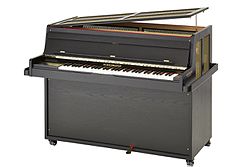This article includes a list of general references, but it lacks sufficient corresponding inline citations. (December 2016) |
 | |
| Keyboard instrument | |
|---|---|
| Other names | Celeste |
| Classification | Idiophone |
| Hornbostel–Sachs classification | 111.222 (sets of percussion plaques) |
| Inventor(s) |
|
| Developed |
|
| Playing range | |
| C3 – F8 | |
| Related instruments | |
| Sound sample | |
| Excerpt from Raymonda by Alexander Glazunov, arranged for solo celesta and performed by Celia García-García | |
The celesta (/sɪˈlɛstə/) or celeste (/sɪˈlɛst/), also called a bell-piano, is a struck idiophone operated by a keyboard. It looks similar to an upright piano (four- or five-octave), albeit with smaller keys and a much smaller cabinet, or a large wooden music box (three-octave). The keys connect to hammers that strike a graduated set of metal (usually steel) plates or bars suspended over wooden resonators. Four- or five-octave models usually have a damper pedal that sustains or damps the sound. The three-octave instruments do not have a pedal because of their small "table-top" design. One of the best-known works that uses the celesta is Pyotr Ilyich Tchaikovsky's "Dance of the Sugar Plum Fairy" from The Nutcracker.
The sound of the celesta is similar to that of the glockenspiel, but with a much softer and more subtle timbre. This quality gave the instrument its name, celeste, meaning "heavenly" in French. The celesta is often used to enhance a melody line played by another instrument or section. Its musical parts are often the duplicate of a theme played on flute, harp or piano; sometimes even a real solo part. It is also used in chamber music, but there are very few concertos written for it. The delicate, bell-like sound is not loud enough to be used in full ensemble sections.
The celesta is a transposing instrument; it sounds one octave higher than the written pitch. Instruments of different sizes exist with ranges of three to five and a half octaves. Its four-octave sounding range is generally considered to be C4 to C8. The fundamental frequency of 4186 Hz makes this one of the highest pitches in common use. The original French instrument had a five-octave range, but because the lowest octave was considered somewhat unsatisfactory, it was omitted from later models before eventually being added back when technology improved. The standard French four-octave instrument is now gradually being replaced in symphony orchestras by a larger, five-octave German model. Although it is a member of the percussion family, in orchestral terms it is more properly considered a member of the keyboard section and usually played by a keyboardist. The celesta part is normally written on two braced staves, called a grand staff.